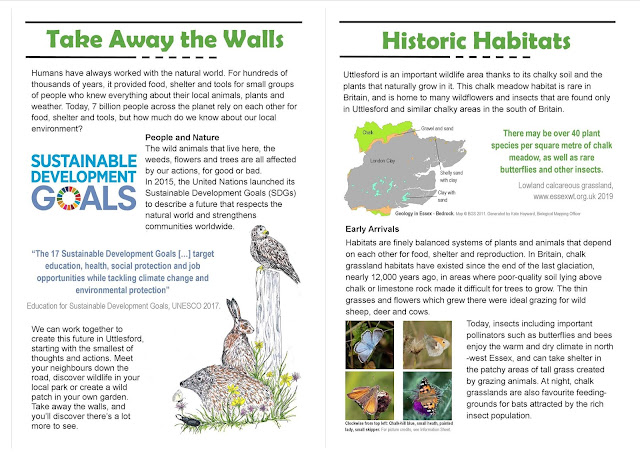Take Away the Walls, a special
exhibition at Saffron Walden Museum, showcased the wildlife of north-west
Essex, and explored how getting outdoors can benefit people and the planet, as
promoted by the UN’s Sustainable Development Goals.
The exhibition explored how human influence has changed
Uttlesford’s distinctive plant and animal communities, and showed visitors how they can create
wildlife hotspots at home. The exhibition also helped visitors to find out where they could enjoy open spaces and
wildlife areas locally, and help local groups protect and preserve these areas
for today and tomorrow.
An activity programme inspired by the Sustainable Development Goals brought together
wildlife groups and community organisations across north-west Essex with local
projects and community events. These partnerships hoped to support lasting
improvements to personal wellbeing, local communities and the wildlife they
sustain.
“The exhibition opens our eyes to the wildlife we see everyday, and reveals its
hidden stories. Humans are often seen as wildlife villains, but we can also be
a huge help to species that are struggling to survive. Not only that, getting
active and spending time outdoors is good for our health, our happiness and for
creating healthy places to live.”
 |
| Historic Habitats display, with important local wildflowers & butterflies and birds and mammals which live in chalky grassland areas. |
A display of farmland, woodland and riverside animals.The American mink is above the badger on the right hand side. They are fearsome predators of water voles, on display to the left of the mink. Water voles became Britain's fastest-declining mammal in the 1990s because of predation by American mink.
 |
| Pressed woodland & fruit tree specimens, and a young buzzard sadly killed by a traffic collision. Buzzards are becoming more common in Essex. |
 |
| Woods & Rivers and Towns & Garden display case showing mammals, birds and insects to look out for in your garden or your local park. |





Comments
Post a Comment